MXA RACE TEST: THE REAL TEST OF THE 2019 KTM 250SX
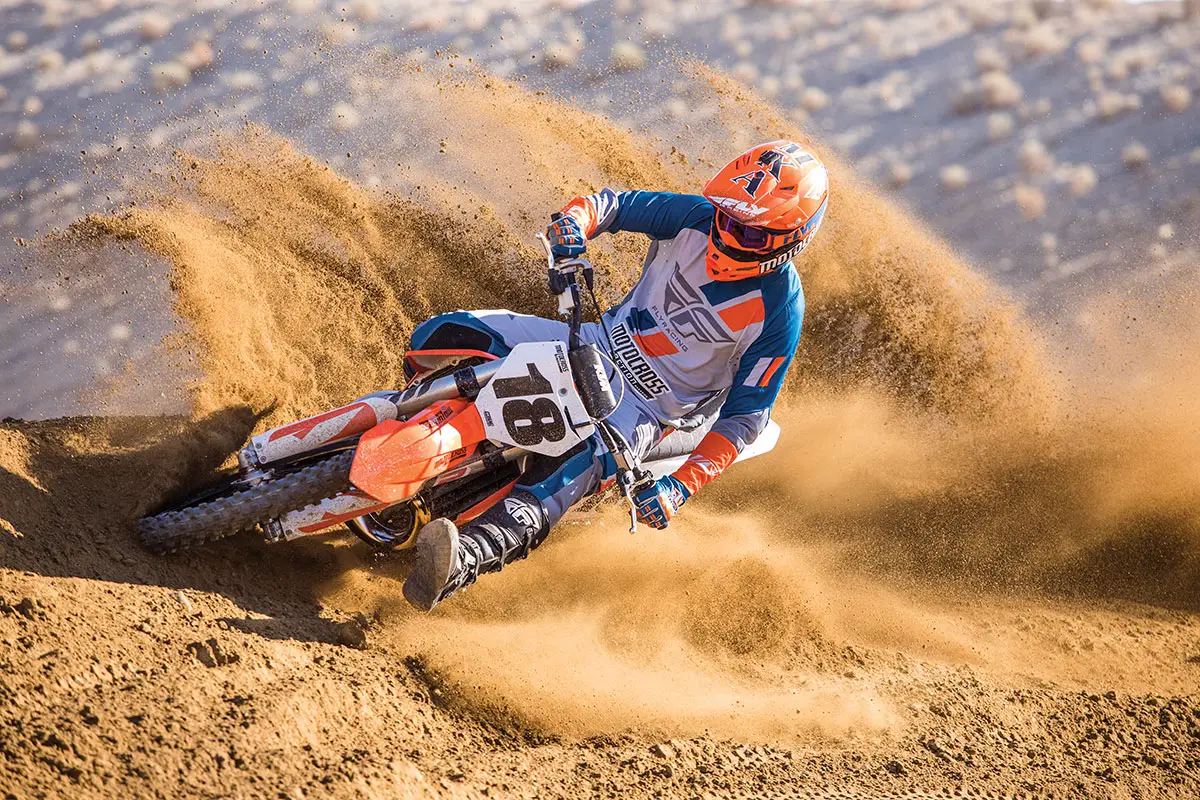
Q: FIRST AND FOREMOST, IS THE 2019 KTM 250SX BETTER THAN THE 2018 250SX?
A: No. Didn’t expect that, did you? In stock trim, the 2019 KTM 250SX is no better than its predecessor, and we have learned after putting countless hours into testing the 2019 450SXF, 350SXF and 250SXF, that the updates KTM made to its 2019 model range, such as the updated frame and airbox, were steps in the wrong direction.
Q: WHAT DID KTM CHANGE ON THE 2019 KTM 250SX TWO-STROKE?
A: The KTM 250SX got the same chassis changes as the rest of the KTM motocross fleet. That includes the more rigid frame, updated bodywork and smaller airbox. Changes that were proprietary to the 2019 KTM 250SX were limited to updated jetting for the 38mm flat-slide Mikuni carburetor, suspension settings, a redesigned exhaust and reworked water-pump casting.
Q: WHAT DOES THE KTM 250SX COST?
A: The 2019 KTM 250SX costs $300 more than it did in 2018 and $500 more than in 2017. The $8199 retail price for the 2019 250SX makes it cost $800 more than the 2019 Yamaha YZ250 two-stroke. We don’t fully understand the price increase, given that over the past two model years the changes don’t seem to justify the 6-percent upcharge. The price tag makes the $7399 YZ250 more attractive.
Q: HOW DOES IT RUN ON THE TRACK?
A: Compared to the 2017–’18 model, it runs more like an offroad bike than a motocross bike. The engineers at KTM tamped down the power on the entire 2019 KTM fleet by making the airbox smaller and more restrictive. Why? We don’t even think KTM knows the answer to that. Most likely, the engineers found something on the dyno that didn’t transfer to the track. That puts the onus for the powerband problems on the KTM test riders. Every MXA test rider complained immediately about the muted low-to-mid power output. Why didn’t KTM’s test riders?
We admit that the 2017 and 2018 KTM 250SX powerplant was at times overly aggressive. The previous KTM 250SX powerband exploded in the midrange and signed off fast on top, leaving test riders wanting more breadth. In 2019, the restrictive airbox not only mutes the aggressive feeling but doesn’t aid in connecting the rest of the powerband together.
Don’t get us wrong; this is still a fast 250cc two-stroke. It just isn’t as fast as it was last year. With the choked-up low-to-mid, the power doesn’t build quickly enough, which makes our testers abuse the clutch to get into the meat of the power—and that meat doesn’t last long enough. The 2019 KTM 250SX still signs off early on top but is now very muted on the bottom. That is a recipe for confusion. It is worth noting that slower test riders, especially those who felt that the 2018 KTM 250SX hit too hard, liked the muted power as it was easier to control.
We had jetting issues in 2017 when KTM switched from the tried-and-true Keihin PWK carburetor to the unfamiliar Mikuni TMX. The carb switch created a jetting nightmare. In 2018, the stock jetting was improved. We only had to change the pilot from a 45 to a leaner 42.5 and go out a turn and a quarter on the air screw. For 2019, the 250SX can run the box stock jetting without any major hiccups. It does run a bit rich, but after we drilled holes in the airbox cover, it leaned out to run nice and crisp. KTM’s engineers still insist on running a 60:1 oil to gas ratio, while they want the KTM 125/150SX to run 40:1.
Q: WHAT CAN A 2019 KTM 250SX OWNER DO TO SMOOTH OUT THE POWER DELIVERY?
A: If the 2019 KTM 250SX feels sluggish to you (and if you are a racer, it will), the first thing to be done is to let the engine breathe. How? By drilling holes in the airbox cover. Don’t be scared. The more holes you drill, the better the power gets—with the caveat not to drill any holes next to or in front of the air filter. The additional air flow will liven up the power significantly. Maybe more than you want. That is okay. There are simple things you can do to tailor the power to your liking.
(1) Gear it up. KTM didn’t hear us last year when we said that the most beneficial change to make to the KTM 250SX was taller gearing. They changed a significant number of things for 2019 but left last year’s stock 14/50 gearing in place. We will admit that this gearing combo works okay with the suppressed power of the 2019 250SX, but every racer is going to take advantage of the cheap horsepower gain of opening up the airbox. The drilled airbox allows the power to run through the short powerband quicker. Gearing the 250SX at 14/49 will smooth out the power, lengthen the gap between gears and make it feel like it pulls further in the rpm range, thus requiring the rider to shift less.
(2) Adjust the power valve. The power-valve adjuster on the starboard side of the engine is a valuable tool for tuning the 250SX power to your liking. Don’t let the square tuning adjuster scare you off. You simply need a Robertson wrench or a flat-bladed screwdriver (which we use) to adjust the power-valve tuner. Turning the setting out (counterclockwise) brings the 250SX powerplant to life faster. If you turn it too far, the powerband will become erratic and abbreviated. Going in on the power-valve adjuster (clockwise) smooths out and mellows the powerband. Please note that small adjustments make big changes to the power delivery. We use 1/8th-turn adjustments. Testers found their sweet spot at 1-1/2 turns in from all the way out. This slowed the revs, extended the powerband and smoothed out the erratic midrange behavior.
Q: CAN THE YAMAHA YZ250 BE COMPETITIVE AGAINST THE 2019 KTM 250SX?
A: Yes, but it didn’t look that way in 2017 and 2018. KTM has opened the door to let the YZ250 sneak back up in the rankings. The 2006 to 2019 Yamaha YZ250s are some of the best overall bikes ever built; however, Yamaha is guilty of benign neglect on the chassis and engine development over the last 12 years. But, the YZ250 still has potential in the 250cc two-stroke marketplace, especially since KTM’s engineers made a serious faux pas on the 2019 air-volume needs. It doesn’t take much more than a Pro Circuit or FMF pipe to bring a YZ250 alive. With the $800 gap between the Yamaha and KTM, YZ250 loyalists can buy bolt-on performance to bridge the power gap that has existed for the last few years.
Q: HOW GOOD ARE THE UPDATED WP AIR FORKS?
A: The 48mm WP AER air forks are very good. They suit a wide range of riders. The recommended psi setting is stiff for the average rider at 149 psi. Even our Pro test riders dropped it down a couple psi. Slower riders and Vets went into the low 140s. That is how air forks are supposed to work. The advantage of an air fork is that the pressure can be changed to fit different track conditions, rider weights and skill levels. As a rule of thumb, if you aren’t bottoming or riding in a harsh spot in the stroke, all is well. Every MXA test rider—fast and slow—turned the compression clicker at least seven clicks softer than the stock setting. This helps break through the zone of harshness in the mid-stroke.
However, the 2019 WP AER air forks don’t feel as good as they did last year, but not necessarily due to the forks’ valving. The increased torsional rigidity of the 2019 frame, stiffer top triple clamps and handlebar feel have changed the flex characteristics of the 2019 KTM 250SX. The reduction of frame flex puts more of the stress on the forks. AMA Pros and super-fast riders can benefit from the increased accuracy of the stiffer frame, but most mere mortals want comfort, not harshness. There is a fine line between too soft and too stiff. KTM has crossed that border.
Q: DID THE SHOCK WORK WELL WITH THE FORKS?
A: At first we had issues with the 2019 KTM 250SX shock that we did not have with the 250SXF, 350SXF or 450 SXF shocks. On our test bike, the WP rear shock felt like a pogo stick. We could not get enough rebound damping, which threw off both high- and low-speed compression damping (since there is a cross-over effect). It turned out, there was debris in the shock body that was causing the issues. After KTM serviced it for us, our testers’ settings were in the ballpark of standard settings. This is a great shock when it is functioning correctly.
Q: WHAT DID WE HATE?
A: The hate list:
(1) Airbox. The small restrictive airbox robs valuable power. There is a fix, but as a rule, we prefer bikes that don’t need the owner to break out a Makita drill.
(2) Price. The benefit of two-strokes, apart from their fun factor and ease of maintenance, is that they have fewer moving parts. Fewer moving parts should result in a lower retail price. In the case of the 2019 KTM, it does—for the Yamaha YZ250.
(3) Frame. Fast riders like the stiffer frame because it is more responsive to rider input. Slower riders don’t like the 2019 frame because it feeds back track roughness.
(4) Shock. There was debris in the shock causing it to function incorrectly. We had to get it serviced to fix it.
(5) Spokes. The updated spoke nipples were supposed to keep the spokes from coming loose. They didn’t.
(6) Engine. This is undoubtedly a powerful engine, although as it sits, it does all its work in the midrange, leaving nothing on top and a sluggish bottom. We want a smoother engine that pulls further.
(7) Gearing. For the love of two-strokes, please make a 49-tooth rear sprocket standard.
Q: WHAT DID WE LIKE?
A: The like list:
(1) Brakes. They are awesome, incredible and delightful.
(2) Hydraulic clutch. KTM’s Belleville washer hydraulic is self-adjusting. Best of all, it can take a beating from a clutch abuser.
(3) Airbox. An airbox does two things: it houses the air filter and it allows the engine to breathe sufficient air to run up to its potential. We love the ease of changing the 250SX’s air filter. We hate the fact that the 2019 airbox has emphysema. It is a love/hate relationship.
(4) Hour meter. We not only like that the 2019 KTM comes with an hour meter, but that it is located on the top of the triple clamps so it can easily be checked.
(5) Forks. The WP 48mm forks work great for a wide range of riders. There is a little learning curve in finding your perfect air pressure, but nothing like the nightmare of PSF and SFF-TAC.
(6) Power-valve adjuster. We love that we can adjust the power valve but hate the weird square tool needed to do it. Buy a Kreft Powerdial to use and adjust without a fuss.
Q: WHAT DO WE REALLY THINK?
A: We don’t like the fact that the 2019 KTM 250SX powerplant feels more like a Husky TC250 than a KTM. The restrictive airbox and stiffer frame make it an inferior-performing machine to the 2018 model. Maybe it’s just us, but we would prefer to stick with our faster, harder-hitting and plusher 2018 KTM 250SX.
MXA’S 2019 KTM 250SXF SETUP SPECS
This is how we set up our 2019 KTM 250SX for racing. We offer it as a guide to help you find your own sweet spot.
WP FORK SETTINGS
As a general rule, first find an air pressure that you like that suits your weight and skill level. Then, start adjusting the clickers. We recommend adjusting the air pressure in 2-pound increments. While the stock air pressure is 151 psi, we had riders who liked it as low as 140 psi. KTM gives you a digital air pump when you buy the bike, so you don’t have to worry about spending the extra cash; you just have to remember to bring it with you to the track. These are the settings we ran on the 2019 KTM 250SX (stock settings in parentheses):
Air pressure: 144 psi (151 psi)
Compression: 32 clicks out (12 clicks out)
Rebound: 15 clicks out (12 clicks out)
Fork height: 1st line (2nd line)
Notes: The stock settings are stiff. All testers lowered the stock air pressure and went out significantly on compression.
WP SHOCK SETTINGS
The KTM WP shock settings are in the ballpark for 2019. All you need to do is set the sag to 105 mm and you should be close to where you want to be. Shorter testers felt the bike was on the high side and dropped the sag to 107 mm to balance the bike. For hardcore racing, we recommend this shock setup for the 2019 KTM 250SX (stock specs are in parentheses):
Spring rate: 42 N/m
Hi-compression: 1 1/2 turns out
Lo-compression: 16 clicks out (15 clicks out)
Rebound: 14 clicks out (15 clicks out)
Race sag: 105 mm
Notes: Take it easy on the preload ring. It deteriorates fast.
MIKUNI TMX 38 JETTING SPEC
Here’s what we ran in our 38mm TMX (stock settings in parentheses):
Main jet: 450
Pilot: 35
Needle: 6BFY43-71
Clip: 3rd
Air screw: 1-1/2 turns out


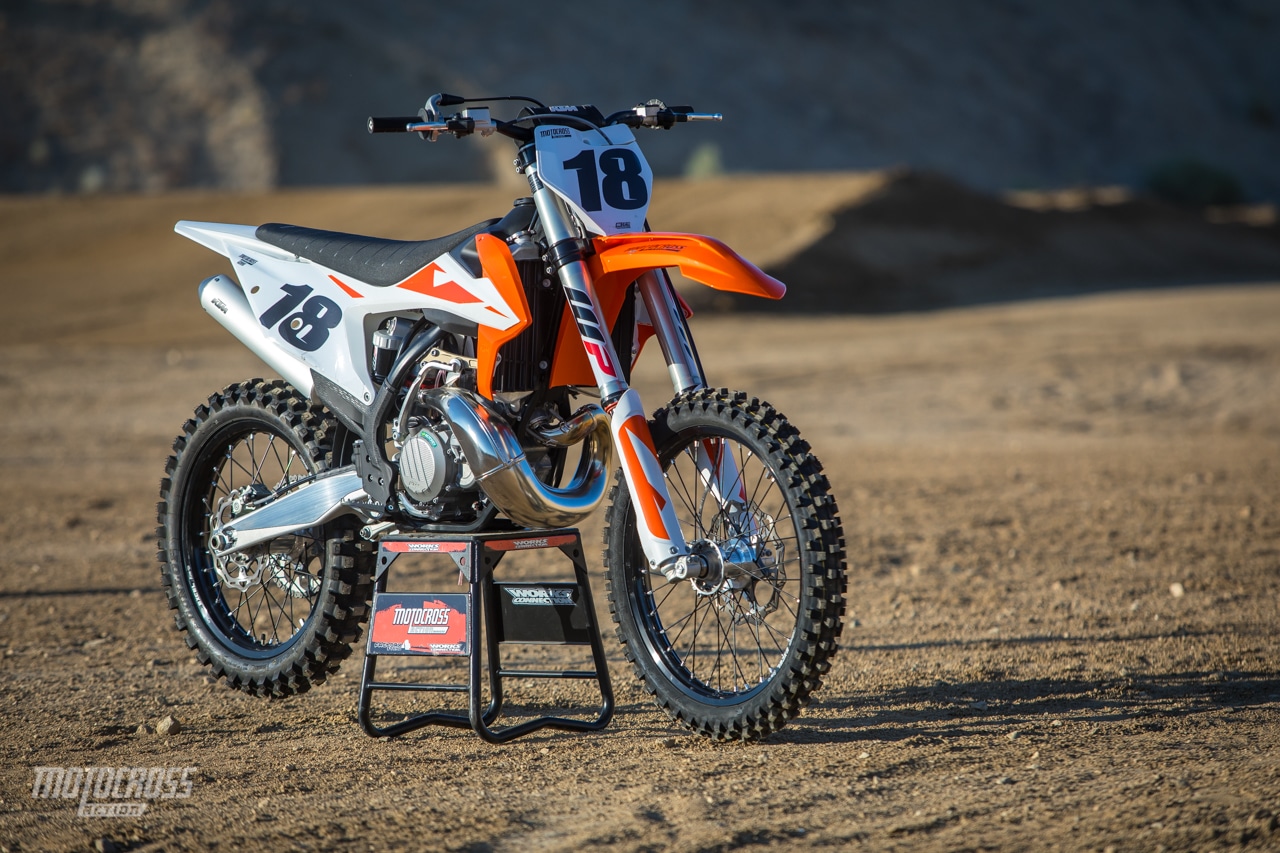
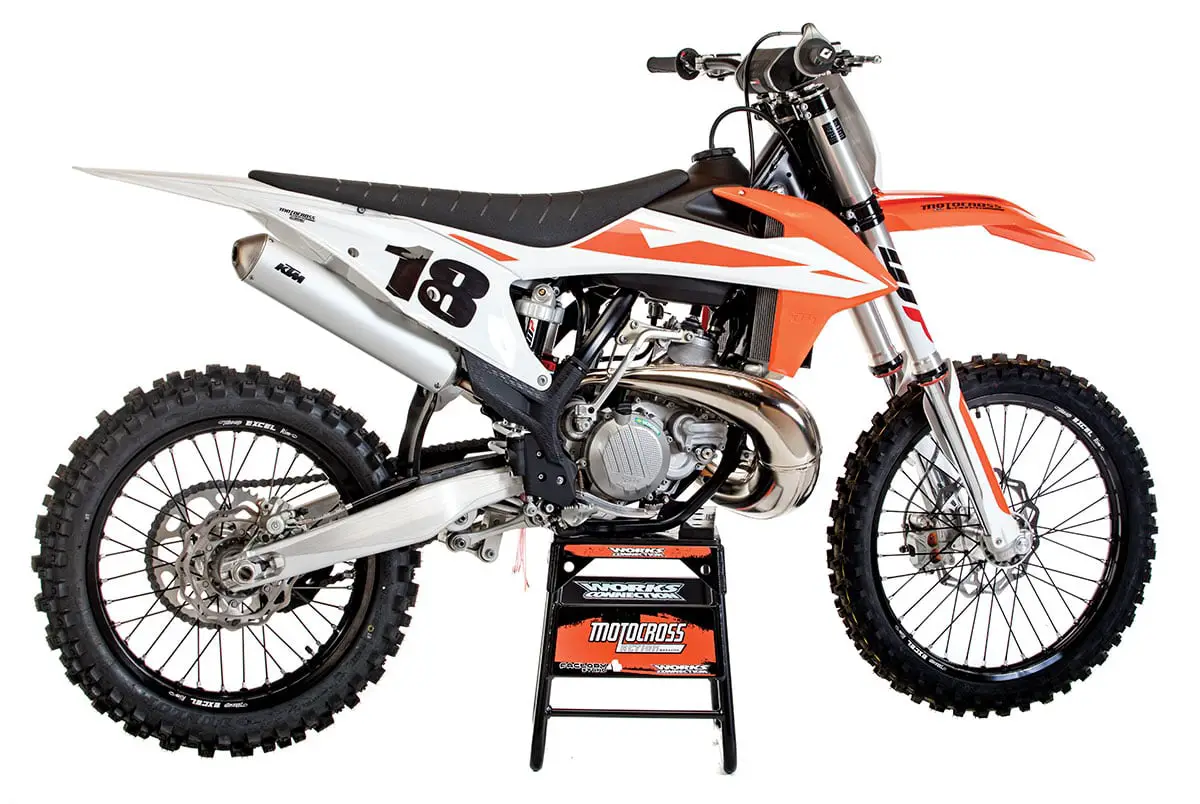
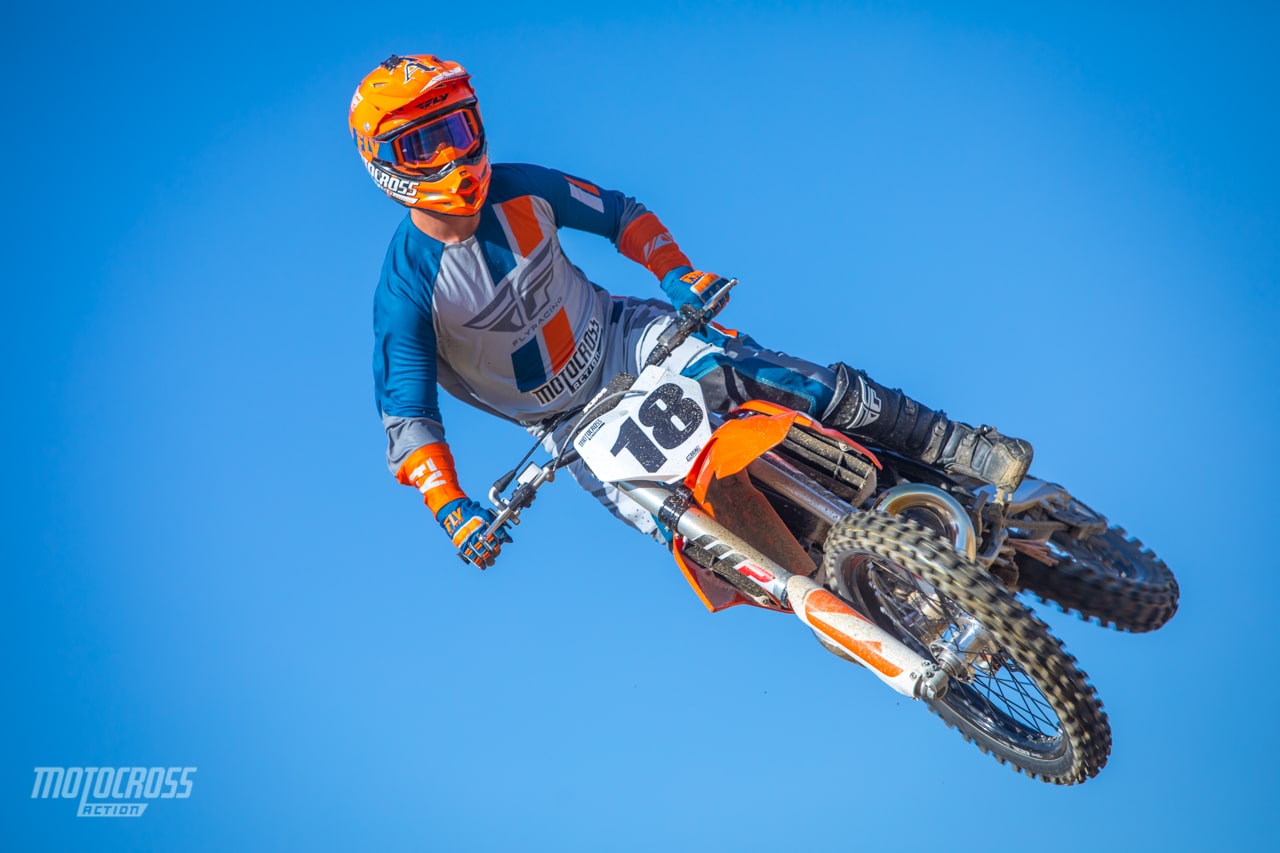
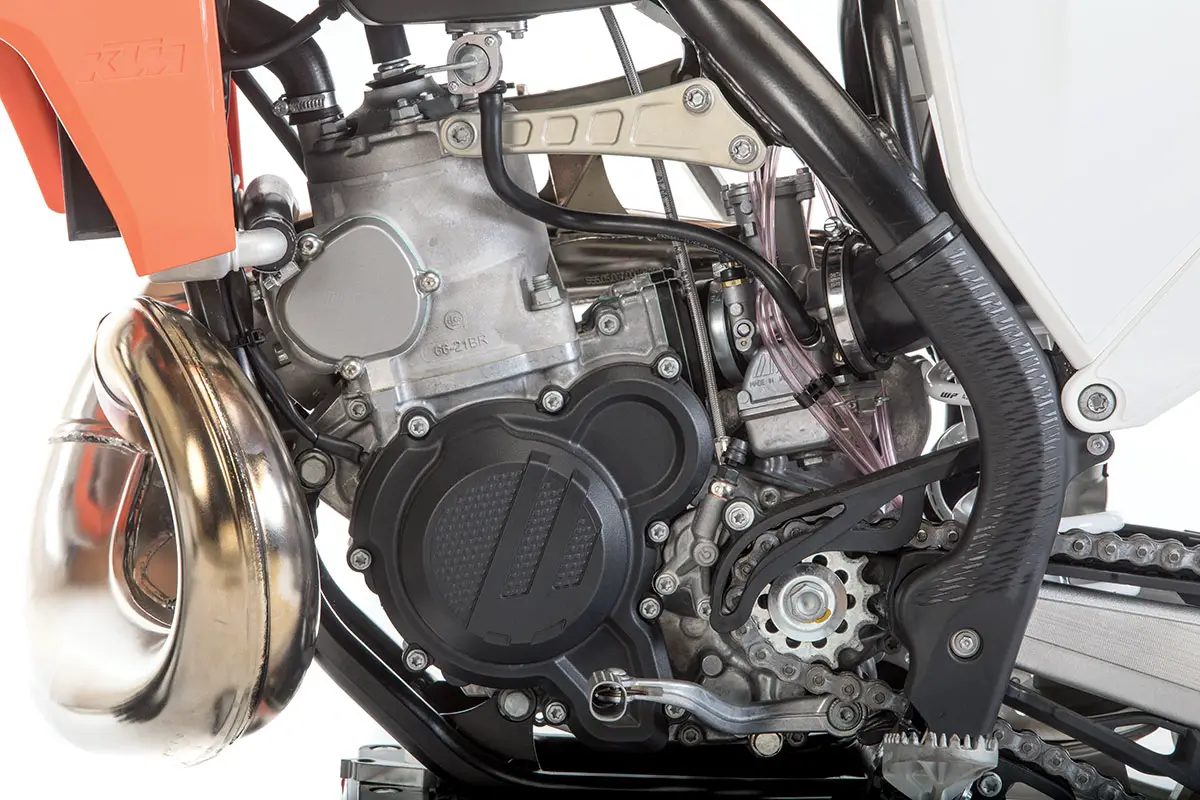




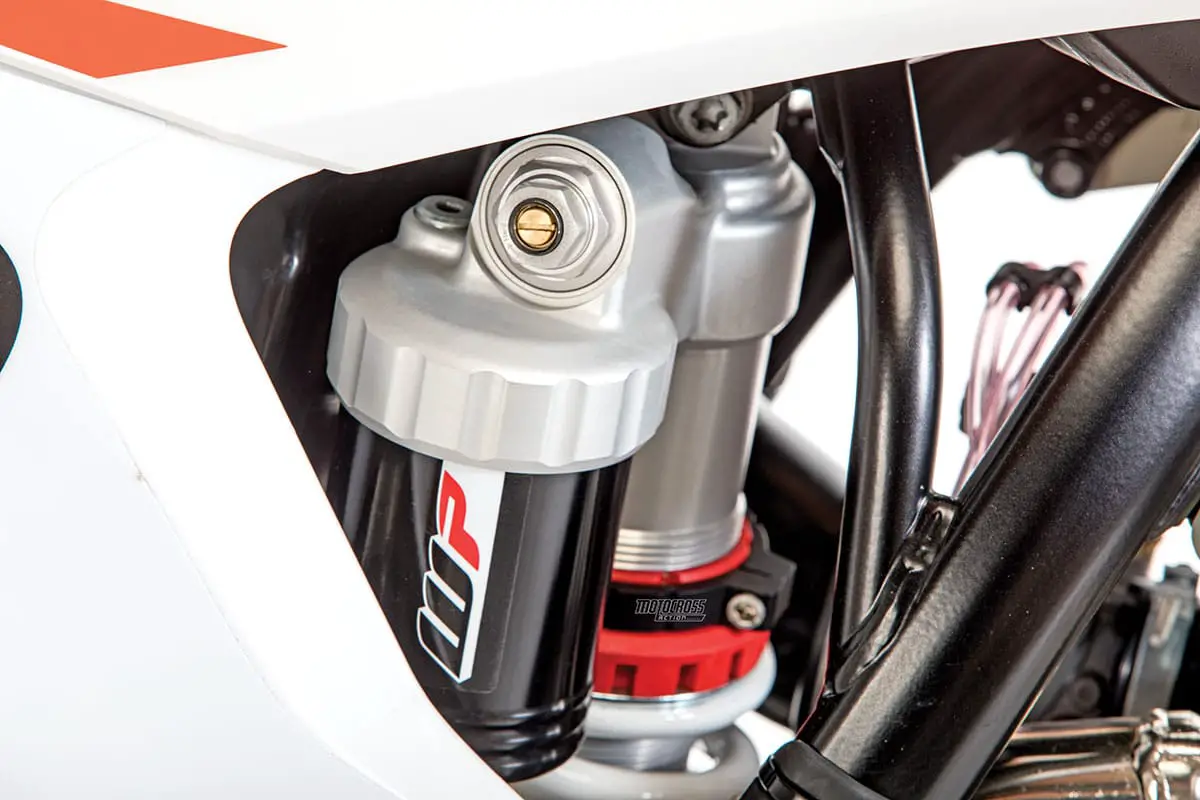




Comments are closed.